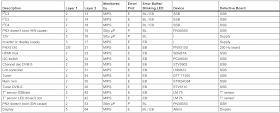PHILIPS INFINITY – BERLINALE – SUNDANCE – BLOCKBUSTER - ERROR CODES - DESCRIPTION - TABLE
ERROR CODES
The error code buffer contains all detected errors since the last time the buffer was erased. The buffer is written from left to right, new errors are logged at the left side, and all other errors shift one position to the right. When an error occurs, it is added to the list of errors, provided the list is not full. When an error occurs and the error buffer is full, then the new error is not added, and the error buffer stays intact (history is maintained). To prevent that an occasional error stays in the list forever, the error is removed from the list after more than 50 hrs. of operation. When multiple errors occur (errors occurred within a short time span), there is a high probability that there is some relation between them.
If no errors are there, the LED should not blink at all in
CSM or SDM. No spacer must be displayed as well.
There is a simple blinking LED procedure for board level
repair (home repair) so called LAYER 1 errors next to the existing errors,
which are LAYER 2 errors.
- LAYER 1 errors are one digit errors.
- LAYER 2 errors are 2 digit errors.
- From consumer mode: LAYER 1.
- From SDM mode: LAYER 2.
Fatal errors, if I2C bus is blocked and the set reboots, CSM
and SAM are not selectable.
- From consumer mode: LAYER 1.
- From SDM mode: LAYER 2
In CSM mode.
When entering CSM: error LAYER 1will be displayed by
blinking LED. Only the latest error is shown.
- In SDM mode.
- When SDM is entered via Remote Control code or the hardware pins, LAYER 2is displayed via blinking LED.
Error display on screen.
- In CSM no error codes are displayed on screen.
- In SAM the complete error list is shown.
Basically there are three kinds of errors:
- Errors detected by the Stand-by software which lead to protection. These errors will always lead to protection and an automatic start of the blinking LED LAYER 1 error.
- Errors detected by the Stand-by software which not lead to protection. In this case the front LED should blink the involved error. {Note that it can take up several minutes before the TV starts blinking the error (e.g. LAYER 1 error = 2, LAYER 2 error = 15 or 53)}
- Errors detected by main software (MIPS). In this case the error will be logged into the error buffer and can be read out via ComPair, via blinking LED method LAYER 1-2 error, or in case picture is visible, via SAM.
How to Read the Error Buffer
Use one of the following methods:
- On screen via the SAM (only when a picture is visible).
00 00 00 00 00: No errors detected
23 00 00 00 00: Error code 23 is the last and only detected
error.
37 23 00 00 00: Error code 23 was first detected and error
code 37 is the last detected error.
Note that no protection errors can be logged in the
error buffer.- Via the blinking LED procedure. [Described in the previous post here].
How to Clear the Error Buffer.
Use one of the following methods:
- By activation of the “RESET ERROR BUFFER” command in the SAM menu.
- If the content of the error buffer has not changed for 50+ hours, it resets automatically.
Error Buffer.
In case of non-intermittent faults, clear the error buffer
before starting to repair (before clearing the buffer, write down the content,
as this history can give significant information). This to ensure that old
error codes are no longer present. If possible, check the entire contents of
the error buffer. In some situations, an error code is only the result of
another error code and not the actual cause (e.g. a fault in the protection
detection circuitry can also lead to a protection). here are several mechanisms of error detection:
- Via error bits in the status registers of ICs.
- Via polling on I/O pins going to the stand-by processor.
- Via sensing of analog values on the stand-by processor or the PNX8550.
- Via a “not acknowledge” of an I2C communication.
ERROR CODE OVERVIEW [Click on image to Enlarge]


